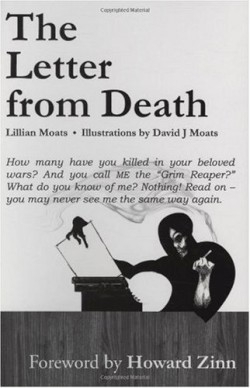The Letter From Death
“Death” is our guide in Moats’ elegant exploration of imagined and constructed hells, the former deriving from pre- and early Christian theological concepts, the latter from medieval and modern military technology. Death is concerned about his image; he’s not happy in his Mayan characterization as Cizan, meaning “Stinking One”; “Grim Reaper” isn’t too bad, but he doesn’t have the needed scythe … and there’s a brighter side: “At least in Voodoo, I’m accorded a little humor, allowed dark glasses and a top hat.”
Death takes us on a guided tour of our impossible imagined hells. He preps us on who is sent to Hell and why. Given original sin and predestination, just about everybody is doomed to end up there; a place in Heaven is first prize in a lottery. But Death admirably prepares us, addressing how long we might suffer never-quenched fire, insomniac worms, smoldering sewage, and other demanding sensory challenges. We also get an insider’s account: the splendid Vision of Tundale, the report of an Irish monk who took an imagined tour of Hell and then wrote it up.
Death then poses his question: if we so fear imagined and impossible hells, why have we created real ones: those of weaponry, war, and destruction; hells from which, if we have not managed to get ourselves killed, we will return maimed and broken for life? “What weapon,” he asks, “made you finally invincible?” Death takes us on a guided tour of weaponry, from cudgel to satellite-guided missiles, also considering our glorification of war, our manipulative rhetoric of “combating evil” and arguing our young “did not die in vain” and the like. His comments on truly caring human behaviors remind us of the terrible contrast between what we could have become and what we are: our own worst enemies, most adept at off-loading blame. The Moats collaboration is truly successful: thought and art are admirably matched.
David Moats’ illustrations truly enhance the text. Lillian Moats’ bibliography of print and electronic sources (many offering case studies of nuclear, chemical and biological weapons and including major works on mind, thought and behaviors) will assist readers to take true stock of the human predicament: our creation of the Death we fear. The Letter, like all the best correspondence, invites re-reading to capture more. Literaryventuresfund.org, instrumental in the publication of this book, is a web site to be closely followed.
Disclosure: This article is not an endorsement, but a review. The publisher of this book provided free copies of the book to have their book reviewed by a professional reviewer. No fee was paid by the publisher for this review. Foreword Reviews only recommends books that we love. Foreword Magazine, Inc. is disclosing this in accordance with the Federal Trade Commission’s 16 CFR, Part 255.

